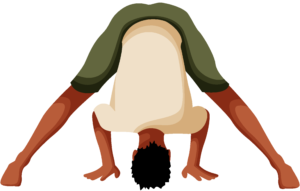Wide-Legged Forward Bend (Prasarita Padottanasana)
Pose Overview
| Common Name | Wide-Legged Forward Bend |
| Traditional Sanskrit Name | Prasarita Padottanasana |
| Sanskrit Name Pronunciation | pra-sah-REE-tah pah-doh-tahn-AHS-uh-nuh |
| Pose Difficulty | Intermediate |
| Drishti
Drishti is the gaze or visual focus point during yoga poses.
Learn more about Drishti |
Tip of the nose |
Wide-Legged Forward Bend, also known as Prasarita Padottanasana, is a standing yoga pose that is both challenging and invigorating. This pose requires a lot of balance, flexibility, and strength, particularly in the legs. It is a great pose for intermediate level practitioners, as it requires a good amount of flexibility in the legs and back. This is a great pose for those looking to improve their balance, focus, and overall strength.
Benefits of Wide-Legged Forward Bend
Strengthens the legs and back Stretches the hamstrings and back Improves balance and focus Opens the chest and shoulders Calms the mind
How to Enter Wide-Legged Forward Bend
Begin by standing in Tadasana (Mountain Pose) at the top of your mat. Step your feet wide apart, about four to five feet apart. Turn your toes out to a 45-degree angle. Exhale and bend forward from the hips, keeping your back straight. Place your hands on the floor, fingers pointing forward. Keep your head and neck in a neutral position and gaze forward. Hold the pose for five to ten deep breaths.
How to Exit Wide-Legged Forward Bend
Inhale, press your hands into the floor, and straighten your arms to come up to a standing position. Exhale, and release your hands to your sides.
Common Wide-Legged Forward Bend Modifications & Variations
If you are unable to touch the floor, place your hands on blocks or on your shins. If your hamstrings are tight, bend your knees slightly.
Common Mistakes with Wide-Legged Forward Bend
Rounding the back Locking the knees Placing the feet too close together
Safety Guidance
Be sure to keep your back straight and engage your core to avoid rounding your back. Keep your legs strong and engaged to avoid locking your knees. If you have any knee or back injuries, modify the pose or avoid it altogether.

